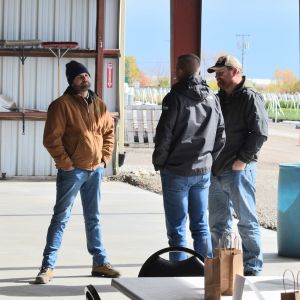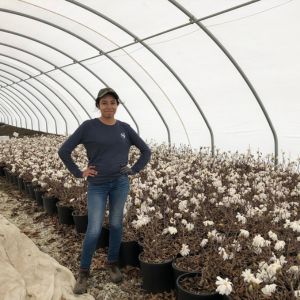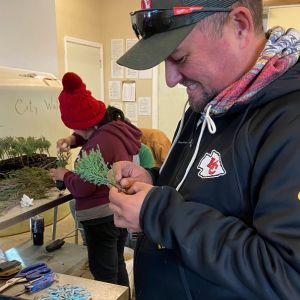From monitoring temperatures in the poly houses to printing tags for spring planting – Loma Vista Nursery never sleeps. Department team leaders and members give us a quick look at what’s happening behind the scenes.

Kurt Everett, left, sales manager, talks with colleagues attending an industry event.
I know that 2024’s trade shows are already on your calendar. What are the advantages of going to trade shows during the off-season months?
The one big advantage to winter shows is that the nursery isn’t usually as busy at the time. It’s nice to be able to focus on the trade show and not be distracted or pulled away, which is common for trade shows that occur during the growing season.
What are the main reasons people attend trade shows?
Education and networking. Winter is a perfect time to catch up on new plants, trends and technologies while touching base with current connections and making new ones. Trade shows are a microcosm of opportunities.
What is the best part of attending trade shows?
For me, it’s connecting with customers. It’s always great to see people in person that sometimes you only talk with on the phone. It’s hard to get out and see every customer during the season and, even then, it’s difficult to sit down and talk during the busier months. A trade show is a great way to get face-to-face time away from the office.

Angie Gutierrez, shipping manager, is checking her list twice to make sure we have everything that’s needed for spring shipments.
What are you doing this month to prepare for the spring rush?
We start ordering supplies for the following year at the end of December. We begin receiving them in January, so this month we have been making sure we are stocked up on all shipping supplies. That way we don’t have to worry about running out or running low on material until the end of spring rush, which is around the beginning of June.
We recently received a shipment of pallets for the plant racks. What materials do you need to start building them? When will we start putting them together for spring?
About 95% of the racks that we ship out are the EZ Racks. The only materials required for those, apart from the parts that they send, are the pallets. This makes it very simple and quick when it comes time to build them, which is usually during the last week of February.

Angel Duran, shipping assistant, says focusing on organization in winter is important for efficiently managing the spring rush.
How does pre-printing sales tags in winter help us in spring?
For example, we are currently pre-printing sales tags for two of our retail customers. Organization is always important. So, for one client, we group together all of their tags and print them by plants and sizes, and then separate them accordingly into bags. Then, we organize the bags into a box, which makes it easy for the processing team to access the tags during spring.
The other client’s tags get printed by orders. We place those into envelopes with the corresponding order number so we can just pull from the envelope when the order is ready to ship.
The main reason for this process is because once spring hits everything starts to pick up rather quickly. Any opportunity to get a head start is beneficial for everyone involved.

Phil Davis, propagation manager, preparing plants for spring.
What is the process of seeding perennials for spring? What plants are currently being propagated from seed?
Yes, we are keeping busy. We have finished the majority of our seeding, including echinacea and grasses along with many other perennials. This process can be time consuming due to seed size being small and ensuring the correct number of seeds are planted per cell.
Are there any specific plants that we are able to propagate in winter?
Three months ago, we stuck our boxwood and evergreens and made our juniper grafts. They have been rooting under fog and floor heat. Our grafts currently have the original top and graft on one root system. In the next week, we will cut the original tops to 50%. This slowly gives the wanted top graft control of the bottom rootstock.
Our crews are also cutting back our overwintered perennials. Overwintering will ensure a fully rooted, hardy premium plant this spring.
What percentage of our plants do we propagate in-house?
Currently, we are propagating about 80- to 85% of our plants on the nursery.

Torrae George, inventory manager, is in the thick of ‘plant planning.’
What updates do you make to the inventory in winter?
A lot! We do a plant cycle count right before winter kicks in and before we cover the poly houses for the season, so that’s been done and we know what we have. We’re currently consolidating existing plant material into pre-planned locations by the years they were initially planted. This makes our system nice and organized. Pulling plants for shipment is quicker and more efficient in the spring. Then, we discontinue unused, old ready dates and remove those plants from our catalog. We also have seed orders coming in.
At the back end, we’re updating the templates for ongoing invoices on existing purchase orders, while drafting new-order templates and inputting them into the system. And we’re finalizing royalty and production reports for our vendors.
What is the benefit of running inventory reports throughout the year?
Running regular inventory reports helps us analyze trends and track changes. This helps us see comparisons among plant families and categories over time, which keeps production informed and is a good way to track improvements.
What plant and material orders do you typically have coming in during January?
Mostly, we’re getting perennial seeds in right now.
Torrae’s responses were really short and a bit confusing because of that. I took liberties with her answers,, but would appreciate input for anything that’s incorrect. In future, for efficiency, can you please ask that responses be thorough replies rather than part-sentences? Also, if industry jargon is used please spell it out (e.g. URC). Thank you!

Mike Sellars, nursery generalist, is helping to keep things running smoothly.
Do we monitor the heat in the perennial houses? What happens when the temperature drops too low?
All the perennials we grow are hardy in the areas where we sell and do not require heat during winter. Just like in your landscape at home, plants can get damaged by a late freeze once they awake from winter dormancy. We protect our sellable perennials in March, April and May by keeping them in the greenhouses that have heaters. This keeps them above 32 degrees should it get that cold.
What goes into preparing for the return of our H2A team members?
We have 16 apartments that house our H2A team members. There are 10 weeks during winter that those units are vacant. So, we’re currently inspecting each unit and addressing maintenance needs or repairs. We also provide transportation in the form of 15-person passenger vans. These must be inspected by the Department of Transportation.
Among your responsibilities, what other tasks are typically happening this month?
We are performing our SANC training for all full-time employees. This is a ‘Systems Approach to Nursery Certification’ that is a voluntary, audit-based program. It is designed to reduce pest risks associated with the movement of nursery stock.
Loma Vista Nursery is taking professional trade orders for the spring 2024 growing season. Click here for our container order form. Click here for our in-ground tree order form. Visit our plant catalog for more information about Loma Vista Nursery grown perennial plants, trees and shrubs – all ideal for Midwest landscapes.
Learn More About the Loma Vista Nursery Family and Our Landscape Plants
Loma Vista Nursery grows fun and healthy plants for Midwest independent garden centers, landscape contractors and wholesale distributors. Review our website to learn about our values and best-practices as a Midwest plant grower.
Our staff members are experts in the field who love helping people learn and understand more about plants. To get help with your orders and answers to plant-related questions, send an email to sales@lomavistanursery.com or call (785) 229-7200.
Connect With Us
Stay current on our plant recommendations, growing tips and more by following us on social media.
